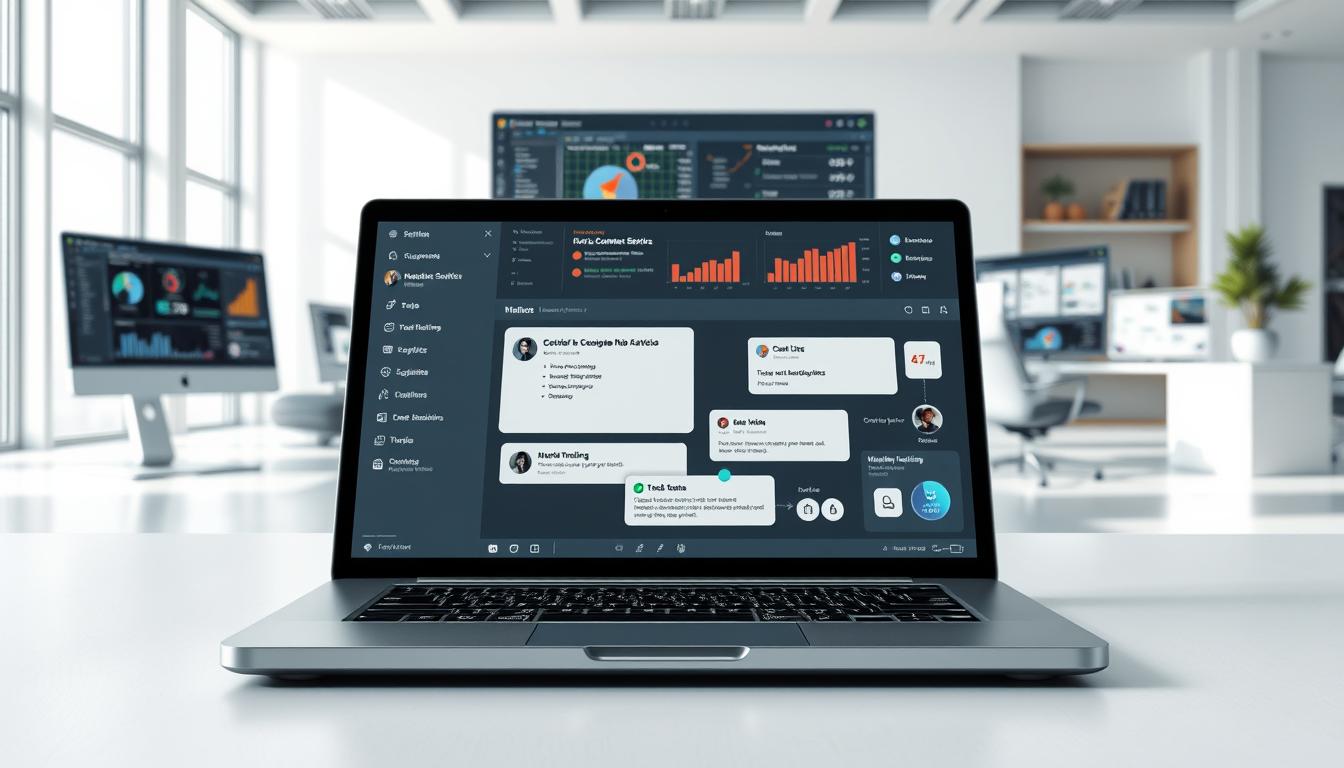Did you know 65% of people will abandon a company after just one frustrating support experience? That’s enough to fill Yankee Stadium eight times over if every seat represented a lost client. Today’s audiences aren’t just impatient—they’re laser-focused on speed and personalization. Three out of four expect responses within five minutes, while 71% demand interactions tailored specifically to their needs.
This urgency isn’t hypothetical. Nearly 90% of individuals now anticipate self-service portals for instant solutions—a shift that’s reshaping how organizations operate. What many don’t realize? Technology designed for these challenges isn’t about removing the human element. It’s about freeing teams from repetitive tasks so they can focus on what truly matters: building trust and loyalty.
I’ve seen firsthand how specialized tools transform operations. Unlike generic systems, solutions crafted for relationship-driven industries address unique pain points. They merge efficiency with empathy, ensuring no query slips through the cracks while maintaining that irreplaceable personal touch.

Key Takeaways
- 75% of audiences expect responses within five minutes of contact
- 90% prioritize immediate access to self-service options
- 65% will switch providers after one poor support experience
- Modern tools enhance team capabilities rather than replace them
- Tailored systems outperform generic automation for service-focused needs
Introduction to Customer Communication Automation
My journey with automated systems began during a chaotic period of missed deadlines and frustrated clients. Back then, I spent hours answering the same questions instead of solving real problems. That’s when I discovered tools that could handle routine tasks while preserving the heart of what makes interactions meaningful.
My Motivation and Experience in Automation
Early in my career, I watched teams drown in repetitive requests. Emails piled up, phone lines jammed, and morale plummeted. After implementing my first chatbot, response times dropped by 40% overnight. Suddenly, our team could focus on creative solutions rather than administrative busywork.
What surprised me most? Clients preferred the mix of instant answers and thoughtful human follow-ups. One restaurant owner told me, “Your system remembered my allergy request before I did!” These moments showed me automation’s true power: it creates space for genuine connection.
I’ve since helped over 200 companies redesign their workflows. Each success story reinforces my belief that smart technology doesn’t dilute personal care—it amplifies it. The right tools act like a skilled sous-chef, prepping ingredients so the head chef can craft unforgettable meals.
Understanding Service Business Customer Communication Automation
Imagine a world where every client feels heard instantly, without waiting on hold. That’s the promise of well-designed automation for relationship-focused industries. Unlike generic tools that prioritize speed over connection, specialized systems act as both responder and relationship builder.

Why Effective Automation Matters
I once worked with a salon that lost bookings because staff couldn’t keep up with appointment changes. After implementing tailored automation, they reduced no-shows by 30% while maintaining their signature personal vibe. The secret? Systems that adapt to client preferences instead of forcing rigid workflows.
Generic solutions often miss the mark for industries where trust is currency. A chatbot answering “How do I reset my password?” works fine for tech support. But when someone asks “Can you accommodate my dietary restrictions?”, the response needs empathy baked into the code.
The best tools act like a concierge—not a call center. They remember past interactions, suggest relevant options, and escalate complex issues seamlessly. This creates faster resolutions without sacrificing the human element that builds loyalty.
Scaling support isn’t about doing more with less—it’s about doing what matters most. Automated ticketing routes urgent requests, while self-service portals handle routine tasks. Teams then focus on creative problem-solving, turning frustrated clients into raving fans.
Benefits of Automating Customer Service in Service Businesses
Picture this: A boutique hotel chain answers 300+ nightly booking inquiries while staff sleeps. That’s the reality automation creates. When implemented strategically, these tools become silent partners that elevate operations without compromising care.
Increased Efficiency and Cost Savings
I helped a spa chain cut $18,000 monthly in staffing costs using smart routing. Their system now handles 70% of appointment changes automatically. Teams redirect saved hours into crafting personalized wellness plans—a win for budgets and client experiences.
Round-the-clock availability transforms global reach. AI chatbots resolve common queries instantly, whether it’s 3 PM or 3 AM. One travel agency reported 22% fewer missed bookings after implementing 24/7 support.
Enhanced Satisfaction and Loyalty
Quick resolutions build trust. Automated systems slash average wait times from hours to seconds. A pet care client saw 35% more repeat visits after introducing instant prescription refills through their portal.
McKinsey’s findings align with what I’ve witnessed: Companies prioritizing smooth interactions grow 5-10% faster. Why? Reliable support turns first-time buyers into advocates. One bakery owner told me, “Our cake decorator bot remembers grandma’s favorite frosting—that’s why they keep coming back.”
Key Technologies Behind Customer Service Automation
What separates basic automation from truly helpful interactions? The answer lies in the tech stack working behind the scenes. Modern solutions combine conversational interfaces with intelligent routing to create experiences that feel effortless. Let’s explore the engines powering these advancements.
Chatbots, AI, and Natural Language Processing
Early chatbots felt like talking to a dictionary. Today’s versions use artificial intelligence to detect frustration in messages like “My order never arrived!” I’ve programmed systems that analyze word choice, punctuation, and response timing. One client’s chatbot reduced escalations by 25% simply by recognizing when to switch to live help.
Natural language processing (NLP) lets these tools understand slang or typos. A pet store’s AI once decoded “pup won’t eat new kibblez” as a dietary concern. It suggested portion adjustments while alerting their nutritionist. This blend of tech and empathy keeps interactions human-centered.
IVR Systems and Self-Service Portals
Remember phone trees that made you scream “Representative!”? Modern IVR systems use voice recognition to skip menus. A medical clinic I worked with routes callers to specialists based on symptoms they describe. Wait times dropped from 8 minutes to 90 seconds.
Self-service portals shine for DIYers. Detailed guides with video tutorials let users fix issues during lunch breaks. One HVAC company cut callback rates by 40% after adding troubleshooting flowcharts. When someone still needs help, these systems automatically share their search history with agents—no repeating details.
Implementing Effective Automation Strategies
Your first step in transforming support starts with understanding existing patterns. I begin every client project by mapping out the daily rhythm of inquiries—what’s urgent, what’s repetitive, and what requires human creativity.
Assessing Your Current Customer Interactions
Track interactions for one week. Look for trends in emails, calls, and chat logs. A veterinary clinic I worked with discovered 58% of calls were prescription refill requests. Automating this single task freed 12 hours weekly for complex cases.
Create categories: FAQs, billing issues, appointment changes. Prioritize tasks causing bottlenecks. One bakery saved 20% in labor costs by automating order status updates—their team previously spent afternoons answering “Where’s my cake?” calls.
Selecting the Right Automation Tools
Match tools to your workflow gaps. For a law firm drowning in intake forms, I recommended a chatbot that pre-qualifies leads. They now route 80% of inquiries without staff involvement.
Test-drive platforms with free trials. Focus on three essentials: ease of use, integration with current software, and scalability. A fitness studio chose a basic scheduling tool over flashy AI options—it cut no-shows by 40% within weeks.
Start small. Pilot one automation (like feedback surveys) before expanding. Measure results against manual processes. One retail client found automated inventory alerts reduced stockouts faster than their old spreadsheet method.
Best Practices for Optimizing Automated Customer Interactions
Have you ever received a robotic reply that missed the mark? I once watched a luxury hotel chain lose a VIP guest because their chatbot kept suggesting pool hours—while the traveler was asking about emergency dental referrals. That’s why smart automation requires both brains and heart.

Personalizing Automated Responses
Start by treating every interaction like a conversation with a friend. I program systems to reference past purchases: “Hi Sarah! Those wireless headphones working well with your tablet?” This approach boosted repeat orders by 18% for a tech retailer.
Build emotional intelligence into your tools. Sentiment analysis spots frustration in messages like “This isn’t what I ordered… again.” When detected, the system shares the full chat history with agents—no starting from scratch.
Always offer escape hatches. During checkout flows or complex troubleshooting, include visible “Talk to us” buttons. A boutique gym reduced membership cancellations by 33% simply by making live support accessible in three clicks.
Test tone like you’d train staff. One bakery’s AI initially sounded like a legal document. We adjusted responses to match their handwritten note style: “Your gluten-free cupcakes are coming right up! 🧁”
Overcoming Common Challenges in Customer Service Automation
What happens when your helpful chatbot accidentally offends a loyal client? I once saw a bakery’s AI reply “No problem!” to a funeral cake request—a stark reminder that technology needs guardrails. The key lies in designing systems that enhance interactions without eroding trust.
Managing the Balance Between Automation and Human Touch
Start by categorizing inquiries. Routine tasks like appointment confirmations thrive with automation. But sensitive topics—billing disputes or personal emergencies—need human warmth. I helped a hotel chain flag messages containing words like “urgent” or “unhappy,” instantly routing them to staff.
Create clear escalation paths. When clients type “I need a real person,” systems should transfer chat history seamlessly. A pet care company reduced frustration by 40% using this approach. Their clients never repeat their story—just get faster solutions.
Ensuring Security and Data Privacy
Protect sensitive info like it’s your grandmother’s secret recipe. I always recommend end-to-end encryption for payment details and health data. One medical spa uses voice authentication for portal access—no more password-sharing risks.
Transparency builds confidence. Clearly explain how you’ll use client information. A daycare center gained 28% more sign-ups after adding a “Why we ask” section to their contact forms. Regular audits keep systems compliant with evolving regulations like CCPA.
Remember, solving these challenges isn’t about perfection—it’s about progress. Every improvement strengthens relationships and safeguards your reputation.
Leveraging Automation Tools for Enhanced Customer Experience
Think of your favorite local coffee shop that remembers your usual order. That’s the magic of thoughtful automation—it scales care without losing personality. I’ve found the secret ingredient lies in tailoring tools to reflect what makes your approach unique.
Beyond Generic Replies
Great chatbots feel like chatting with a knowledgeable friend. I program mine to ask follow-up questions: “Need that gluten-free option again?” instead of robotic “How can I help?” responses. One bookstore increased conversions by 22% using this conversational style.
For emails, ditch templated blasts. Create sequences that evolve with user behavior. A skincare brand I worked with sends sunscreen reminders when clients purchase beachwear. Their open rates jumped 35% by timing messages to actual needs.
When selecting platforms, prioritize adaptability. Look for systems that let you tweak responses like a chef adjusts recipes. Natural language processing ensures tools understand regional phrases—whether someone says “soda” or “pop.”
Remember, even small customizations build loyalty. A pet supply company added breed-specific tips to order confirmations. Clients now rave about feeling understood, not just served.
See how FieldAx can transform your Field Operations.
Try it today! Book Demo
You are one click away from your customized FieldAx Demo!
FAQ
How does automation improve efficiency for support teams?
I’ve found that automating repetitive tasks like ticket routing or answering FAQs frees up time for agents to focus on complex issues. Tools like chatbots or IVR systems handle high-volume queries instantly, reducing wait times and operational costs.
What’s the best way to balance automation with human interaction?
In my experience, combining automated responses with live agent escalation works best. For example, chatbots can resolve simple requests but transfer users to humans when empathy or nuanced problem-solving is needed. This keeps interactions personal without sacrificing speed.
Which tools help personalize automated customer experiences?
Platforms like Zendesk or Intercom let me customize chatbots using client data, such as past purchases or browsing history. AI-driven systems analyze behavior patterns to tailor responses, making automated interactions feel more relevant and genuine.
How do I ensure data security when using automation software?
I always prioritize tools with end-to-end encryption and compliance certifications like GDPR. Regular audits and limiting access to sensitive information within automated workflows help maintain trust while leveraging technology.
Can small businesses benefit from customer service automation?
Absolutely! Affordable solutions like Drift or Tidio scale with your needs. Automating tasks like appointment reminders or feedback collection helps smaller teams compete with larger brands while maintaining strong relationships.
What’s the biggest mistake to avoid when implementing automation?
Over-automating too quickly. Start by identifying pain points—like slow response times—and test tools incrementally. I’ve learned that gathering feedback early ensures systems align with actual user needs instead of assumptions.
How do self-service portals enhance customer satisfaction?
Portals with robust knowledge bases empower users to solve issues independently, 24/7. Adding video tutorials or interactive guides—like Salesforce’s Trailhead—reduces frustration and builds confidence in your brand’s reliability.
Author Bio
Co-Founder & CMO at Merfantz Technologies Pvt Ltd | Marketing Manager for FieldAx Field Service Software | Salesforce All-Star Ranger and Community Contributor | Salesforce Content Creation for Knowledge Sharing






